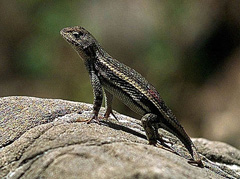You are here
Hews, Diana K

Ph.D., University of Texas at Austin
Phone: 812-237-8352
E-mail: Diana.Hews@indstate.edu
Office: Science Building 346
Editorial Board Member, Integrative and Comparative Biology (Oxford University Press), 2008-2013
Program Officer, Animal Behavior Society (Western Hemisphere), 2006-2009
Research Interests: behavioral endocrinology; evolution of sexual dimorphism; visual and chemical signals and social communication; stress physiology; environmental endocrine disruptors.
Sexual selection is responsible for many differences between males and females (sexual dimorphism), and it also can result in relatively discrete differences among males (Alternative Reproductive Tactics) that can be as extreme as male-female differences. Research in Dr. Hews' laboratory examines sexual selection at the interface between physiology and evolution. Dr. Hews seeks to identify the sources of selection favoring the evolution of such between- and within-sex differences, and how the underlying hormonal control of such differences has been shaped by natural and sexual selection. Differences in behavior, particularly aggression and territoriality, and in related morphological traits (body size, body mass, color signals) are the focus of work in the Hews lab. Interactions and trade-offs between sexually-selected signaling traits and other physiological systems, including immunocompetence and the hypothalamic-pituitary-adrenal axis, are studied. A new focus is starting to examine the effects of environmental endocrine disrupting compounds on sexual differentiation, in vertebrates that occur in the Wabash Valley wetlands.
 Males of Sceloporus virgatus are an example of a species without blue abdominal patches that most other male Sceloporus express. Sexual dimorphism is ancestral for Sceloporus so this white abdomen represents a male loss of a secondary sexual trait.
Males of Sceloporus virgatus are an example of a species without blue abdominal patches that most other male Sceloporus express. Sexual dimorphism is ancestral for Sceloporus so this white abdomen represents a male loss of a secondary sexual trait.
© 2001 by David Sanders
A major area of research in Dr. Hews' lab involves the study of color signals & chemical signals used in social communication. A relatively new long-term project focuses on fence lizards (Sceloporus). Males of some Sceloporus species are "feminized": these species have evolutionarily lost the color signals that, in most Sceloporus, are expressed only in males. Males in these species are also less aggressive than males of typical species. In other species, females are "masculinized", expressing this normally "male-only" color trait and also elevated levels of aggression. Thus, Sceloporus species differ in the degree and nature of some aspects of sexual differentiation. Hormone manipulations can identify actions of early (pre-hatching and hatchling) and late (adult) differences in hormone levels in contributing to species differences in sexual differentiation. Comparing among species will identify how hormonal control mechanisms have evolved. Histological description of color signal production in several Sceloporusspecies have assisted in identifying cellular targets of hormone action. Current work is examining the epithelium of the vomeronasal organ (VNO), and asking if there asex and species differences in VNO size that map on to sex and species differences in the relative importance of chemicals signaling and aggression in Sceloporus.
Dr. Hews emphasizes studying animals in the wild, where the full array of social and environmental stimuli are present. Field studies or studies with captive animals in outdoor enclosures manipulate hormones, social conditions, or color signals to determine the effects on aggressive interactions, and, in longer-term studies, to document sources of selection acting on the color signals. Laboratorymanipulations of hormones compliment field studies. Other major laboratory techniques include radioimmunoassay of plasma steroid hormone levels, ELISA, and immunohistochemisty. Techniques used to study immune function in wild vertebrates include WBC counts, hemagglutination assay using sRBC challenge, a delayed-type hypersensitivity assay (using injections og KLH as a antigen to cause swelling), and a bacterial killing assay (BKA) to assess innate immunity. Examples of field techniques used include staged territorial challenges to measure hormonal and behavior responses, territory mapping and focal animal observations to record rates of key behaviors.
SELECTED PUBLICATIONS
Seddon RJ, Hews DK (2017) Correlates of melanization in multiple high- and low-elevation populations of the lizard, Sceloporus occidentalis: behavior, hormones and parasites. Journal of Experimental Zoology A 327: 481–492.
Ossip-Drahos AG, Oyola Morales J, Vital García C, Zúñiga-Vega JJ, Hews DK, Martins EP (2016) Shaping communicative signals over evolutionary time. Royal Society Open Science 3: 160728.
Pruett JA, Zúñiga-Vega JJ, Campos SM, Soini HA, Novotny MV, Vital-Garcia C, Martins EP, Hews DK (2016) Evolutionary interactions between visual and chemical signals: chemo-signals compensate for the loss of a visual signal in male Sceloporus lizards. Journal of Chemical Ecology 42: 1164-1174.
Seddon RJ, Hews DK (2016) Populations of the lizard, Sceloporus occidentalis, that differ in melanization have different rates of wound healing. Journal of Experimental Zoology, Part A 325: 491-500.
Seddon RJ, Hews DK (2016) Phenotypic correlates of melanization in two Sceloporus occidentalis (Phrynosomatidae) populations: Behavior, androgens, stress reactivity, and ectoparasites. Physiology & Behavior 163:70-80.
Lawing AM, Polly PD, Hews DK, Martins EP (2016) Including fossils in phylogenetic climate reconstructions: A deep time perspective on the climatic niche evolution and diversification of Spiny Lizards (Sceloporus). The American Naturalist 188: 133-148.
Martins EP, Ossip-Klein AG, Zúñiga-Vega JJ, Vital C, Campos SM, Hews DK (2015) Evolving from static to dynamic signals: evolutionary compensation between two communicative signals. Animal Behaviour 102: 223-229.
Hews DK, Abell-Banicki AJ (2013) The breeding season duration hypothesis: acute handling stress and total plasma concentrations of corticosterone and androgens in male and female striped plateau lizards (Sceloporus virgatus). Journal of Comparative Physiology B 183: 933-946. DOI 10.1007/s00360-013-0766-z.
Ossip-Klein AG, Fuentes JA, Hews DK, Martins EP (2013) Information content is more important than sensory system or physical distance in guiding the long-term evolutionary relationships between signaling modalities in Sceloporus lizards. Behavioral Ecology & Sociobiology 67(9): 1513-1522. doi:10.1007/s00265-013-1535-4.
Hews DK, Hara E, Anderson MC (2012) Sex and species differences in plasma testosterone and in counts of androgen receptor-positive cells in key brain regions of Sceloporus lizard species that differ in aggression, General & Comparative Endocrinology 176:493-499
Robertson JM, Hoversten K, Grundler M, Poorten TJ, Hews DK, Rosenblum EB (2011) Colonization of novel white sands habitat associated with changes in lizard anti-predator behavior. Biological Journal of the Linnean Society 103: 657-667.
Hews DK, Date P,Hara E Castellano MJ (2011) Field presentations of male secretions alter social display rates in Sceloporus virgatus but not in S. undulatus lizards. Behavioral Ecology & Sociobiology 65:1403-1410.
Quinn VS, Hews DK (2010) The evolutionary decoupling of behavioral and color cues in a multicomponent signal in two Sceloporus lizards. Ethology116: 509-516.
Thaker M, Lima SL, Vanak AT, Hews DK (2010) Hormonal mediation of aversive learning: attack intensity affects memory in a wild vertebrate. American Naturalist 175: 50-60 and Supplemental Online Materials.
Thaker M, Lima SL, Hews DK (2009) Corticosterone mediation of antipredator responses in male lizards with alternative reproductive tactics. Hormones & Behavior 56: 51–57.
Thaker M, Lima SL, Hews DK (2009) Alternative antipredator tactics in tree lizard morphs: hormonal and behavioral responses to a predator encounter. Animal Behaviour 77: 395-401.
Calisi RM, Malone JH, Hews DK (2008) Female secondary coloration in the Mexican boulder spiny lizard (Sceloporus pyrocephalus) is associated with nematode load. Journal of Zoology, London 276: 358-367.
Baird, T.A. and Hews, D.K. (2007) Plasma levels of steroid hormones in territorial and non-territorial male collard lizards. Physiology & Behavior 92: 755–763.
Calisi, R.M. and Hews, D.K. (2007) Steroid correlates of multiple color traits in the spiny lizard, Sceloporus pyrocephalus. Journal of Comparative Physiology Series B: 177:641-654.
In Preparation
Hews DK, Curtis JL, Thaker M, Baird TA. Male collared lizards and testosterone levels in response to staged territorial intrusions: a test of the Challenge Hypothesis.
Cain PW, Gardner B, Thaker M, Hews DK. Color patch size and fluctuating asymmetry in maleSceloporus undulatus lizards: relationships with habitat disturbance and body condition.
Pruett JA, Hews DK, Martins EP. Behavioral responses to conspecific chemicals in free-ranging males of four Sceloporus species that differ in aggressive coloration
Hews DK, Leache AD, Shawkey MD, Barnes DJ. Nanostructural and Fourier analysis of dermal iridophores in Sceloporus lizards with evolutionary variation in blue signaling patches.
Quinn VS, Hews DK. Abdominal coloration and female preference behavior in two Sceloporus lizards: an experimental study.
Quinn VS, Hews DK. The influence of androgens in development and expression of secondary sex characteristics in the sexually dichromatic Sceloporus undulatus consobrinus and monochromatic S. virgatus lizards.
Hews DK. Experimental assessment of the role of plasma androgens in aggression of adult maleSceloporus virgatus lizards.
Kabange Z, Hews DK. Peripheral white blood cell counts, cellular and humoral immune responses ofSceloporus undulatus lizards: age and sex differences.
Chakraborty M, Kabange Z, Hews DK. Effects of androgen manipulations on cellular and humoral responses to KLH immune challenges in adult male Sceloporus undulatus lizards.
